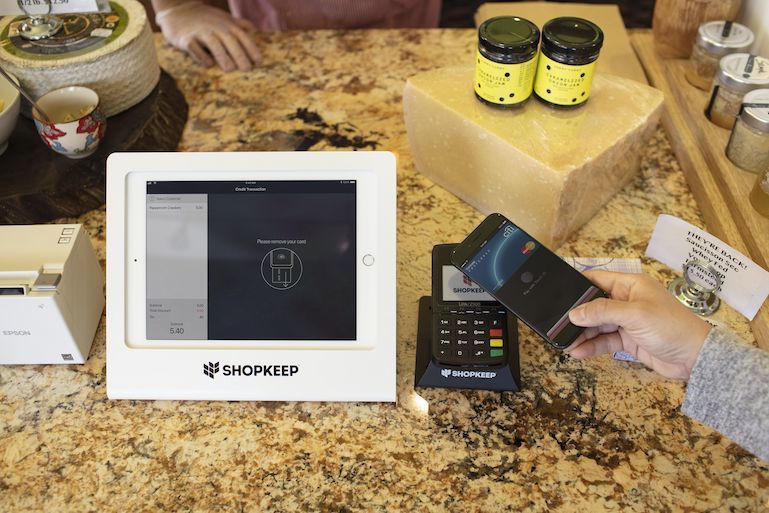
How Can Credit Card Processing Fees Affect Your Business?
Processing fees: one of the not-so-fun perks of being a small business owner. If you accept credit cards, it’s up to you, the merchant, to decipher the differences between credit card processing fees and determine which fee structure works best for their business.
So how can credit card processing rates affect your business? In short, they can cost (or save) your business big bucks in the long run. Read on to learn why.
How Does Credit Card Processing Work?
We’ll make this quick. Every time a customer swipes their credit card at your shop, you accept the payment with a credit card reader.
Then a credit card processor collects the payment information and sends it to the card network (like Visa and Mastercard). The card network receives the transaction information and sends it to the issuing bank (the institution that issued the credit to your customer in the first place).
This credit card issuer then approves or denies the credit request, and that judgement is sent to you, the merchant. That’s when ‘approved’ or ‘denied’ appears like magic on your credit card reader. But as you’ve just learned, those credit card transactions are not quite magic, and most of the parties are collecting fees along the way.
There is at least one last step, which is when the issuing bank sends funds to the acquiring bank (the bank that processes payments for you, the merchant). But in this article, we’re going to focus on initial transaction fees. As a merchant, you’re actually responsible for three main fees: interchange fees, assessment fees, and processor markup fees.
SEE ALSO: How To Accept Credit Card Payments
What Are Interchange & Assessment Fees?
Every time you accept credit card payments, money flows from the issuing bank to your acquiring (merchant) bank. For facilitating this, the credit card companies charge a fee, which is then paid to the issuing bank. So no, credit card companies aren’t directly benefiting from the transaction fees, but credit card associations set the rates, so feel free to blame them as you see fit.
Currently, the average interchange rate for a credit card is 1.81%, and the average rate for a debit card is 0.3%. The fee consists of a percentage of the total transaction + a fixed amount. For example, 1.6% + 10¢. Every individual card has a separate interchange fee, which is substantially more when a credit card is keyed in as opposed to swiped. According to The Wall Street Journal, “Merchants also typically pay higher swipe fees on the more generous Visa and Mastercard rewards cards—typically more than 2.1% of a purchase on premium rewards cards, compared with roughly 1.2% to 1.7% on more standard rewards cards.” As a general rule, debit cards have the lowest fees.
Assessment fees, on the other hand, are paid to the card associations. It’s a much smaller fee, around .13% for debit cards and .11% for credit cards. The assessment is usually combined into the interchange fee.
Though you’ll see a bundled fee, it might surprise you to learn that the interchange “fee” is actually over 300 interchange fees. The rates change twice a year, and vary between card associations. Visa and Discover tend to have the lowest interchange fees, while American Express has the highest—and in fact, American Express doesn’t even call their fee an interchange fee, even though it is essentially the same thing.
Because these rates are set by the credit card associations, every merchant pays the same current interchange and assessment rates. Unfortunately for you, the merchant, these fees are not negotiable and need to be considered as part of your overall budget. Some business owners try to avoid fees by choosing to not accept credit cards or by setting a credit card minimum. By trying to skirt the fees, however, you run the risk of frustrating customers who aren’t carrying cash, who may not return or leave you a poor review online. You might also be inadvertently breaking your agreement with card processing networks (Visa, Mastercard, etc.).
A better solution is choosing a modern point of sale system that will automatically calculate the current rates while accepting credit cards, in one seamless swipe. In today’s economy, many consumers never carry cash, so, unfortunately, transaction fees are a cost of doing business.
SEE ALSO: How To Save On Credit Card Processing Fees
What Are Payment Processor Markup Fees?
On top of the interchange fee, a merchant is hit with a convenience fee on each purchase, which may or may not include the interchange fee. Let us explain.
Flat Rate Processing Fees
Some payment processors, like Square, advertise a flat fee, which is currently 2.75% for a swiped transaction and 3.50% for a keyed transaction. If you think this sounds high, you’re right. Since the average credit card interchange rate is 1.81% (and the debit rate is even lower, at 0.3%), the rest of that fee is Square’s markup.
For some businesses, flat-rate pricing for payment processing makes sense. If you’re a merchant selling a large quantity of small-ticket items, generally $3 or less, you might save money by using a flat-rate processor, especially if you’re okay with a very bare-bones POS system. A coffee truck, for instance, wouldn’t need much in the way of point of sale software.
The main benefit of a flat fee is, of course, its simplicity. You, the merchant, are able to calculate how much you will need to pay per transaction in advance, assuming every customer pays with a card.
Most businesses, however, will benefit from a more flexible pricing model that adds a small fee on top of the interchange rate. This is known as interchange plus pricing.

Interchange Plus Pricing
An interchange plus pricing model is exactly what it sounds like: your credit card processor charges a small amount on top of the interchange fee. For example, if the interchange rate is 1.51% + 10¢ per transaction, the processor may charge 0.5% + 15¢ per transaction, which comes out to 2.01% + 25¢ per transaction. That’s generally less than a flat rate and, remember, debit cards and many credit cards have even lower interchange rates. If you’re selling large or medium-size ticket items, you’re probably coming out ahead with interchange plus in terms of pure math.
The larger benefit, however, is the flexibility. As your business grows, you will probably outgrow the bare-bones point of sale software that comes with a flat-rate payment processor like Square. You’ll likely need software tailored to your business that will help you streamline operations. POS software like ShopKeep allows you to use the payment processor that’s right for you so you always get the best rate. (Or you can use our proprietary processor, ShopKeep Payments, if you wish.)
Remember, interchange rates change a few times every year. Flat-rate processing fees will eventually need to rise to account for rising interchange rates. As a small business owner, if you are not able to see the most recent interchange rates, you have no idea if you’re saving or losing money with your processor.
There is a third pricing model that you’ll come across as you research your options, and this is tiered pricing.
SEE ALSO: Payment Processing 101: Interchange Plus Rates vs. Flat Rates
Tiered Pricing
Many businesses are still tied to a tiered pricing model, which was the standard until a few years ago.
Tiered pricing is when a credit card processor organizes payments into buckets and charges a different rate based on that qualifying criteria. For example, a qualified discount rate might be 1.05%, while a non-qualified discount rate could be over 3%.
The difference between these buckets is again based on the interchange fees. A Visa debit card would qualify for the lowest rate, while a keyed-in American Express transaction will cost you. For a merchant, the biggest danger with tiered pricing is not being able to see the interchange rate for each transaction, as you are only shown the tiered buckets on your statement.
A benefit of the tiered approach is that it can be confusing to keep track of all the different credit and debit card rates, so you’re trusting that your acquiring bank (aka the merchant service provider) is giving you the lowest rate possible.
However, your acquiring bank will probably only advertise the lowest qualified discount rate they offer, surprising you when you see higher tiers on your statement. If your customer base tends to use “high-risk” rewards cards (and more and more customers are) you will find that most of your transaction fees will fall in the more expensive, non-qualified discount rate.
If you’re in conversation with a merchant service provider about a tiered-rate pricing model, be sure to ask what their mid-qualified and non-qualified rates are. You can’t control whether someone uses a Mastercard debit card or an expensive Visa rewards card. However, you can know how high your fees may rise.
Is Your Business a Special Case?
Some “controversial” businesses, like those selling firearms or cannabis, can experience an unexpected surprise: many credit card processors will not accept you as a client.
If this situation applies to you, we absolutely recommend that you do not bundle your credit card processor with your point of sale software. Otherwise, you may find yourself having neither.
Most confusingly, some credit card processors will charge higher rates if your business is seen as risky. It might not be fair, but it’s common. So make sure you ask the right questions in order to secure a competitive quote.
Choosing The Processor That’s Right For You
Though we generally find that interchange plus pricing saves small business owners money, your specific business might benefit from a flat rate or even a tiered model. Before you commit to a processor, start by answering initial questions like:
- What is my average ticket price? A $3 donut? A $40 sweatshirt?
- What will my average ticket price be in the future?
- Will any or most of my customers pay in cash?
- How can my business benefit from a robust point of sale system? (And, if your processor comes with its own POS system, what can that system provide?)
- Am I likely to qualify for the lowest possible rates through my merchant service provider?
All businesses are unique, so you will need to run the numbers to see which fee structure works for you.
As your business grows and evolves, remember to periodically check in on your credit card processing rates to make sure you’re still getting the best rate.
Want to try ShopKeep for yourself?
Just answer a few easy questions.
Need help finding the right point of sale?
Just complete the form. We’ll call you right back to explain how ShopKeep can work for you.
Hit the ground running.Sprinting, in fact!
Read our free, comprehensive guide, Small Business 101, to learn all you need to know about starting a thriving business.

